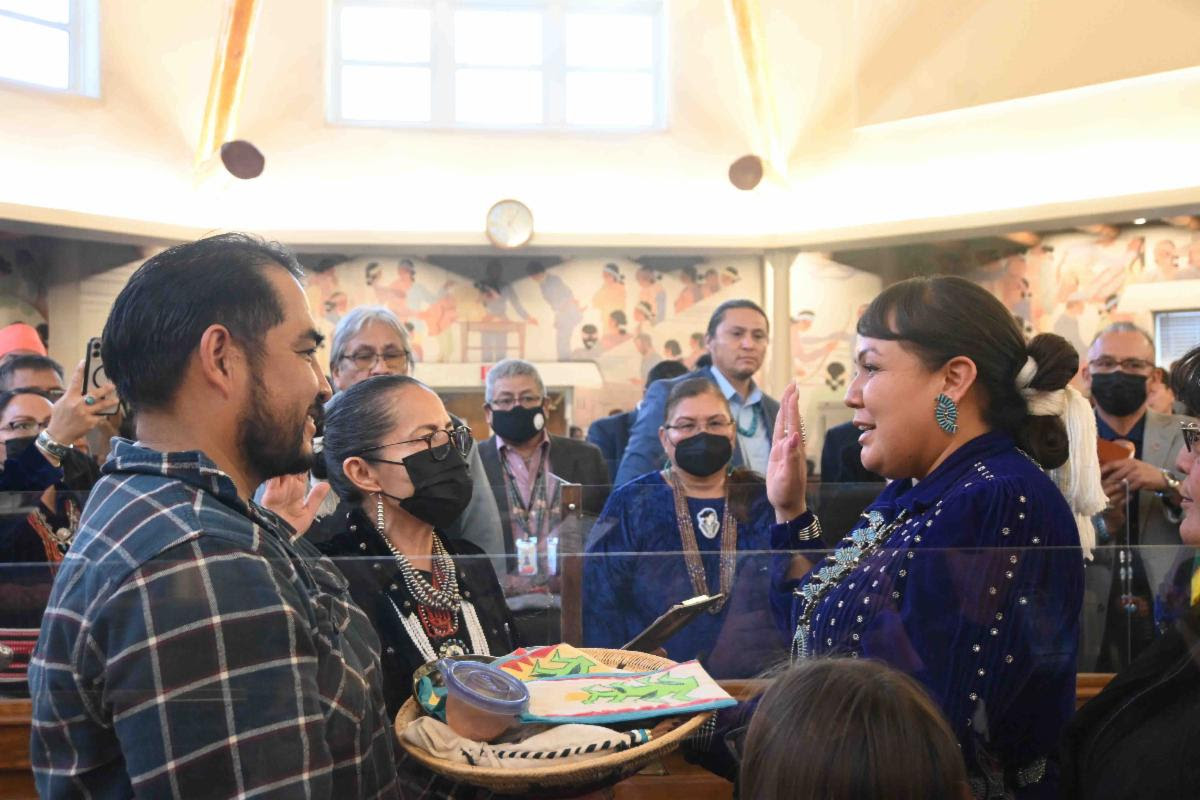
- Details
- By Levi Rickert
History was made on Tuesday when the 25th Navajo Council elected its first female Speaker ever during the opening of its Winter Council session.
The election of Crystalyne Curley as Speaker of the Navajo Council came two weeks after Richelle Montoya was sworn in as the first first-ever female vice president of Navajo Nation and nine women, including Curley, were sworn into the 25th Navajo Council.
The Speaker of the Navajo Council heads the Legislative Branch of the Navajo Nation for a two-year term.
Curley beat three opponents vying for the Speaker position. Among others nominated for Speaker were Council Delegates Eugenia Charles-Newton, Carl R. Slater, and Otto Tso. During a first vote, none of the candidates received the majority of the votes, which led to a run-off election. In the run-off election, Curley received 13 votes and Tso received eleven 11 votes.
Curley is Tsenjikini and born for To'aheedliinii. Her maternal grandfather is Kinyaa'aanii and her paternal grandfather is Dził t'aadi Kinyaa'áanii. She is originally from the community of Fish Point, Ariz., located within the Tsélání/Cottonwood Chapter. She is fluent in the English and Navajo languages.
“I extend my appreciation to my colleagues of the 25th Navajo Nation Council for having the confidence in me to lead the Legislative Branch and to serve as the Speaker of the Council,” Curley said in a statement. “We have many challenging issues to address and I look forward to working collectively with my colleagues and the other branches of government to make progress for our people and communities across the Nation. Through dedication, hard work, and prayer, the 25th Navajo Nation Council will remain committed to positive changes and accountability as we move forward together.”
During the presentation of her platform, Curley said that she strives to be a voice for Navajo people living in remote areas without basic infrastructure and amenities, which she attributed to growing up in a rural community with no electricity or running water.
Despite the challenges of growing up in such conditions, Curley earned two bachelor's degrees from Arizona State University and a Masters in Public Administration from the University of New Mexico.
 Make A Monthly Donation Here
Make A Monthly Donation Here
She previously served as a policy analyst with Diné College and the Navajo Government Development Office. In addition, she served as a Legislative District Assistant and Sr. Public Information Officer for the Office of the Speaker and Office of the President and Vice President before being elected to the Council this past November, representing the communities of Tachee/Blue Gap, Many Farms, Nazlini, Tselani/Cottonwood, and Low Mountain. From 2011-2012, she served as Miss Navajo Nation.
Curley was joined by her spouse, daughter, and mother as Navajo Nation Chief Justice JoAnn Jayne administered the Oath of Office.
More Stories Like This
Native News Weekly (August 25, 2024): D.C. BriefsUS Presidents in Their Own Words Concerning American Indians
Indigenous Actor Elaine Miles Reports Detention by Alleged ICE Agents
Happy Thanksgiving from Native News Online
Coming Up on Native Bidaské: Behind the Animation: Joey Clift Talks “Pow” and Native Storytelling
Help us tell the stories that could save Native languages and food traditions
At a critical moment for Indian Country, Native News Online is embarking on our most ambitious reporting project yet: "Cultivating Culture," a three-year investigation into two forces shaping Native community survival—food sovereignty and language revitalization.
The devastating impact of COVID-19 accelerated the loss of Native elders and with them, irreplaceable cultural knowledge. Yet across tribal communities, innovative leaders are fighting back, reclaiming traditional food systems and breathing new life into Native languages. These aren't just cultural preservation efforts—they're powerful pathways to community health, healing, and resilience.
Our dedicated reporting team will spend three years documenting these stories through on-the-ground reporting in 18 tribal communities, producing over 200 in-depth stories, 18 podcast episodes, and multimedia content that amplifies Indigenous voices. We'll show policymakers, funders, and allies how cultural restoration directly impacts physical and mental wellness while celebrating successful models of sovereignty and self-determination.
This isn't corporate media parachuting into Indian Country for a quick story. This is sustained, relationship-based journalism by Native reporters who understand these communities. It's "Warrior Journalism"—fearless reporting that serves the 5.5 million readers who depend on us for news that mainstream media often ignores.
We need your help right now. While we've secured partial funding, we're still $450,000 short of our three-year budget. Our immediate goal is $25,000 this month to keep this critical work moving forward—funding reporter salaries, travel to remote communities, photography, and the deep reporting these stories deserve.
Every dollar directly supports Indigenous journalists telling Indigenous stories. Whether it's $5 or $50, your contribution ensures these vital narratives of resilience, innovation, and hope don't disappear into silence.
 The stakes couldn't be higher. Native languages are being lost at an alarming rate. Food insecurity plagues many tribal communities. But solutions are emerging, and these stories need to be told.
The stakes couldn't be higher. Native languages are being lost at an alarming rate. Food insecurity plagues many tribal communities. But solutions are emerging, and these stories need to be told.
Support independent Native journalism. Fund the stories that matter.
Levi Rickert (Potawatomi), Editor & Publisher

